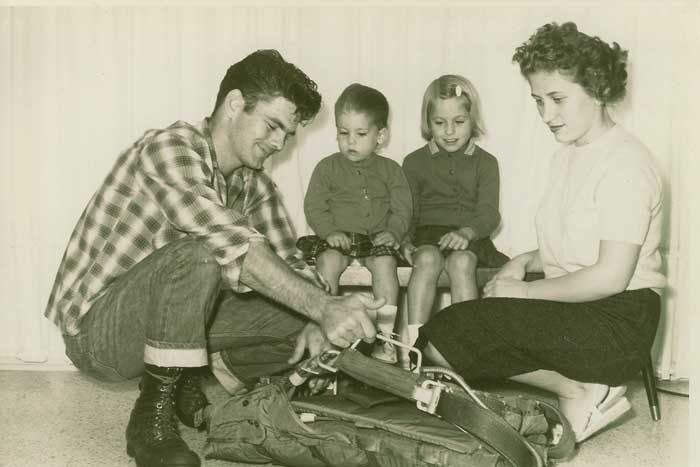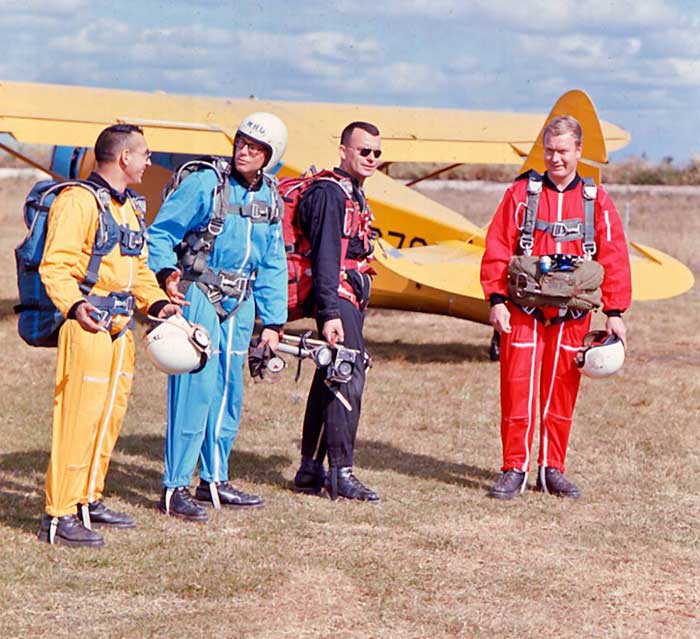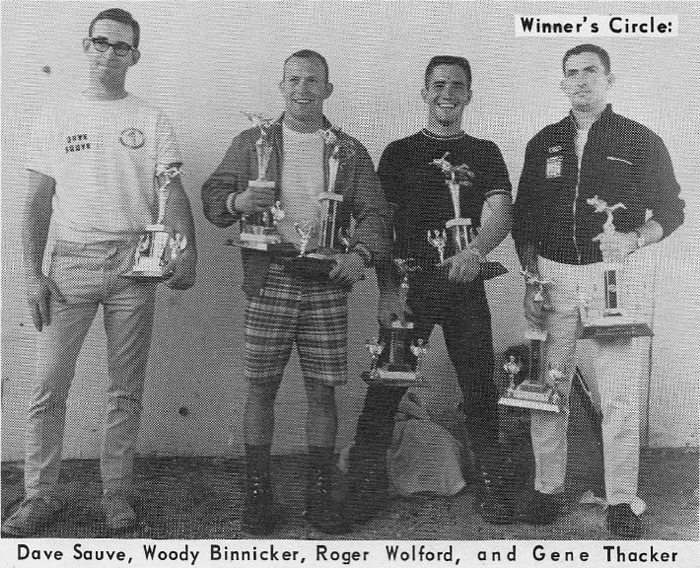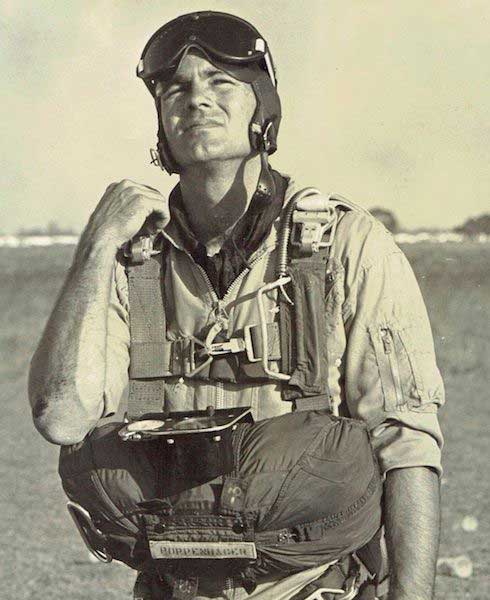SFPI History
Submitted by Gary Corderman D-2510
(For additional history of Indiantown, check out the entriy for Davie and Indiantownsubmitted by Gary Corderman D-2510)
History of South Florida Parachute Inc (SFPI)
Before Clewiston & Indiantown: In 1959, Paul J. Poppenhager (D-47) was a civilian rigger at Homestead Air Force base when he heard about four other guys in South Florida that were making freefall jumps. They got together and formed the first organized parachute club in Florida and called it Broward Skydivers, with 5 jumpers. Poppenhager (Pop) was elected President.
They could not find a plane (or pilot) to jump and had no club money, so they got permission from the FAA to put on an air show, now with 8 jumpers, over a 2-day weekend and charged admission. They advertised it as the First Florida Parachute Meet and held it in Kissimmee, FL. The event (exhibition) was a great success with newspaper coverage from the Orlando Sentinel, and raised enough money from selling admission tickets to buy a jump plane. Best of all the event resulted in about 10 new students wanting to learn to jump. They held a few of these meets/exhibitions to raise money for the Broward Skydiver’s Club.
By 1960, the Club had grown to over a 100 members, from areas well outside of just Broward County. So they changed the name to South Florida Parachute Assoication (SFPA). During the 1960 annual meeting of the Parachute Club of America (PCA); (now USPA), they recognized SFPA and Paul Poppenhager as the Club’s president.
In 1962, the club (SFPA) moved from Dade County to Clewiston, FL after having challenges with the FAA due to airline airspace congestion around the SE Florida coast and especially Miami. It was in 1962 that the Club was becoming much larger, and had “issues” that resulted in Pop deciding, with others, to break-off and form the first commercial skydiving center in Florida, located at Clewiston. The corporation (South Florida Parachute, Inc.) was formed by Paul Poppenhager, (D-47) President; John Myers bought a C-180; Pete Wenk, (D-135) Chief Pilot & Mechanic; and Marty Horvath, (D-88) Sec/Treasurer.
This was a risky venture at the time, and a real challenge for Pop and his wife Carol to undertake considering Pop had to give up his good federal civil service job as a rigger at Homestead AFB. Clewiston is quite a ways from the Florida east coast and it was not clear if skydivers would make the drive to this rural area, it also had to be primarily a weekend business and some of the original Club members were jumping on the coast with a small operation that Richard Schuford (D-100) was running in a field in Broward County. However, it was Pop’s dream to operate a commercial skydiving center.
Shortly after going commercial with SFPI, John Myers moved on to do other things and SFPI bought his C-180. Pete Wenk was drafted into the Army and was gone a few years and Marty Horvath also moved on to other interests – leaving Pop, his wife Carol and young children to make a go of the Clewiston (SFPI) Center. (Pete Wenk after serving in the Army came back for a short period, until getting a job as a Pan American Airlines Chief Engineer, many years later to retire as a PanAm Captain, and remains one of Pop’s good friends to this day.)
Side Story about Bill Ottley: Pop, Carol and children were living in Dade County when one evening someone knocked on the door—it was Bill Ottley. He had made a few jumps in Orange, Mass when winter set-in and he was told to go down to Florida and find Poppenhager if he wanted to jump regularly during the winter. So Bill showed up at their door unannounced asking, “can I jump with you guys”. Pop (and Carol) gave him a place to sleep and the next day Pop, Carol, kids and Bill drove to the clubs operation in Clewiston --- with Bill singing to the kids the whole trip up. While Bill’s first few jumps were at Orange, he learned to freefall in Clewiston and got his B license that winter. Bill and Pop were friends for years after, with Bill coming down almost every winter to jump at SFPI Clewiston, and later Indiantown.
Side Story about D license numbers & PCA Instructor / Examiner numbers: In April 1960, Pop went to the National Parachuting Championships at Ft. Bragg, NC. Competitors needed a D License to participate, so they announced that all jumpers need to get in line to get their D License. Only a few D Licenses had been issued (research indicates about 8). When Pop saw the line, he decided to wait until it got shorter before going over to stand in the long line. They issued about 50 D Licenses at that meet, with Pop ending up with D-47. [If you look at the D License numbers there is a cluster of the Army Team members, which may indicate most of them got in line together, and went on to win 6 places on the U.S. Team at the 1960 Nationals, and they went on to the 5th World Championships in Bulgaria.]
In February 1962, Pop was invited to the first PCA Instructor / Examiner Conference held in Phoenix, AZ (and PCA paid for the trip, which with Pop’s family commitments and trying to make SFPI Clewiston viable was essential for his participation). There were 23 participants, including Brigadier General Joe Stilwell (son of Vinegar Joe Stilwell), Lew Sanborn, D-1, and Jacques Istel, D-2, --- it was the group of the U.S. most experienced skydivers. They decided upon what number they would have by drawing the numbers out of a bag. Pop’s Instructor / Examiner number is #21.
SFPI Indiantown, FL: I’m not sure exactly when SFPI moved from Clewiston to Indiantown, but I believe it was 1965. There is a reference to the 1964 Southeast Conference Annual Parachute Meet in Clewiston, FL (SFPI). Since Pop’s meets were always held in the winter, usually referred to as the Christmas or New Year’s meet, I’m assuming SFPI was still in Clewiston at the end of 1964. As an aside, John Coppe, D-265, a long-time jumper, instructor and pilot at SFPI started jumping in Clewiston when it was still a Club, and of course moved to Indiantown when SFPI relocated.
Poppenhager’s Winter Invitational Accuracy (and style) Meets flourished while operating at Indiantown, FL. While the first Meets/Exhibitions go back to 1959, then Davie, FL in 1960, and later Clewiston most of the references to his Meets being a premier event each winter are from the SFPI Indiantown days. Jerry Irwin has some excellent pictures of the Meets in the 66-67 timeframe, highlighting Pop’s two Howards (Yellow was Pop’s first, Green was his second –which is the one I remember jumping in ‘68).
Indiantown Student Training: In February 1970, SFPI became the first commercial center in the country to teach freefall on the very first jump. I was working full-time for Pop when one Monday he came in and said I’m not doing anymore static lines. That weekend there was a jumper that rolled off the step into the static line and Pop just decided that was enough. I believe it was the U.S. Air Force Academy club that was using Kap-3 (mechanical/spring) automatic openers and Pop decided to order some for his first-jump students and teach a 5 second delay self - pull on the first jump (with the Kap-3 as a safety backup). While USPA was not ecstatic about such an innovative change from static lines to freefall for first jump students, they issued a waiver in 1971 approving the trial. In my view, they knew Pop was an individualist and was doing it anyway, so they approved the “trial”. However, the waiver was carefully worded, noting that any other organization wanting to initiate First Jump Free Falls will need to apply for an individual waiver.
Also in February 1970, when Pop decided to make the change to freefall first jumps, SFPI made another leap forward. He bought a full set of ParaCommanders (PC) mains and started putting first jump students out with the newest PCs. It may not seem like much of an innovation today, when AFF and squares for first jumps are the norm—but it sure was back in 1970. No other jump operation in the country were teaching first jump students with PC’s, let alone freefall for the first jump. Combine these improvements with Steve Snyder reserve automatic openers, radios for students, other top quality gear and outstanding first jump instructors like Carl (Smitty) Smith (D-3034); coupled with meticulously maintained aircraft and SFPI was on the leading edge of student skydiving in 1970, and for the entire decade.
While I could be wrong, as one of the first 23 USPA Instructor / Examiners, Pop was authorized to recommend other USPA Instructor / Examiners—and Carl (Smitty) Smith (D-3034) was the only one he ever recommended for a Instructor / Examiner rating. Pop had many other excellent instructors at SFPI over the years, including Dick Plummer (D-1012), Paul Gatenby (D-1740), John Coppe (D-265) and others before and after my time. While, Pop and SFPI was known for operating in what some thought were “unconventional” ways; when it came to student training SFPI and Paul Poppenhager settled for nothing less than the absolute best equipment, instruction and aircraft.
While operating SFPI Indiantown in 1974, Pop became the first U.S. jumper to reach 5,000 jumps. He had earlier been the first jumper to obtain his Diamond Wings (2,000 jumps) when SFPI operated in Clewiston, FL.
SFPI operated 4 different Twin Beech aircraft from 1974 until they closed in the mid-1980’s. The story of the first Twin Beech is interesting. Pop was not at all confident there was enough RW business to justify the significant financial commitment to buy a Twin Beech. There were a group of jumpers from Delray, FL (Delray Donuts if I recall the team) that really wanted Pop to buy a Twin Beech. So one day, Pop got them together and told them if they would each buy $1,000 worth of 10,500 ft. tickets in advance, he would get a Twin Beech. To Pop’s surprise they showed-up the next weekend with $12,000 and Pop went out and bought his first Twin Beech. Pop said, he was surprised how well the Beech worked-out financially and how soon it was paid-off and a money maker for SFPI.
I started jumping in Indiantown in 1968, and left in 1972 (returning in ’74 to make a couple jumps). I worked full-time at SFPI after high school in 1969, until I left in ’72. Others will have a much better idea of SFPI’s history in Indiantown both before ’68 and after I left. However, I’ve met and talked with others from the early days of the Club and SFPI (Pete Wenk, Marty Horvath, and others from the early 60’s), so I’m confident about that part of the SFPI story.
I also remember the important influence Carol Poppenhager had on the operation, my life, and how much she was admired and loved by all the jumpers. I did not see Carol again after around 1978, but remember Carol’s smile and outgoing personality when she was in her late 30’s and it still warms my heart. I also remember the children well during that time period. Lori Poppenhager was a great packer, working hard each weekend to keep-up with packing rigs – a really hard worker. Suzanne was a little older and made her first jump while I was at the Center. Remember the twins and Paul packing (staff and other experienced jumpers rigs), flaking and using their feet to stuff the canopy’s into the bags – then the older, stronger girls would come around and close the containers. And while I was never old enough to drink a beer while at SFPI, when I emptied the DZ trash containers on Monday mornings I think I saw a few empty beer cans.
Gary Corderman
D-2510


Jim Stoyas, Bill Ottley, Lowell Bachman, and ? Photo by Jerry Irwin

The author, Gary Corderman, 2nd from left with Gov. Kirk. Pop on the right.


Paul Poppenhager in the early 60s
